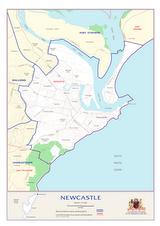Status of the global Climate
The World Meteorological Organisation has released its Statement on the Status of the global Climate in 2006.
The relevant parts of the statement for Australia are:
The global mean surface temperature in 2006 is currently estimated to be + 0.42°C above the 1961-1990 annual average (14°C/57.2°F), according to the records maintained by Members of the World Meteorological Organization (WMO). The year 2006 is currently estimated to be the sixth warmest year on record. Final figures will not be released until March 2007.
Averaged separately for both hemispheres, 2006 surface temperatures for the northern hemisphere (0.58°C above 30-year mean of 14.6°C/58.28°F) are likely to be the fourth warmest and for the southern hemisphere (0.26°C above 30-year mean of 13.4°C/56.12°F), the seventh warmest in the instrumental record from 1861 to the present.
Since the start of the 20th century, the global average surface temperature has risen approximately 0.7°C. But this rise has not been continuous. Since 1976, the global average temperature has risen sharply, at 0.18°C per decade. In the northern and southern hemispheres, the period 1997-2006 averaged 0.53°C and 0.27°C above the 1961-1990 mean, respectively.
Regional temperature anomalies
Persistent extreme heat affected much of eastern Australia from late December 2005 until early March with many records being set (e.g. second hottest day on record in Sydney with 44.2°C/111.6°F on 1 January). Spring 2006 (September-November) was Australia’s warmest since seasonal records were first compiled in 1950.
Prolonged drought in some regions
For many areas in Australia, the lack of adequate rainfall in 2006 added to significant longer-term dry conditions, with large regions having experienced little recovery from the droughts of 2002-2003 and 1997-1998. Dry conditions have now persisted for 5 to 10 years in some areas and in south-west Western Australia for around 30 years.
Development of moderate El Niño in late 2006
Conditions in the equatorial Pacific from December 2005 until the first quarter of 2006 showed some patterns typically associated with La Niña events. These however, did not lead to a basin-wide La Niña and, during April, even weak La Niña conditions dissipated. Over the second quarter of 2006, the majority of atmospheric and oceanic indicators reflected neutral conditions but, in August, conditions in the central and western equatorial Pacific started resembling typical early stages of an El Niño event (see WMO Press Release 765). By the end of the year, positive sea-surface temperature anomalies were established across the tropical Pacific basin. The El Niño event is expected by global consensus to continue at least into the first quarter of 2007.
Deadly typhoons in south-east Asia
Twelve tropical cyclones developed in the Australian Basin, two more than the long-term average. Tropical cyclone Larry was the most intense at landfall in Queensland since 1918, destroying 80-90 per cent of the Australian banana crop.
Ozone depletion in the Antarctic and Arctic
On 25 September, the maximum area of the 2006 ozone hole over the Antarctic was recorded at 29.5 million km², slightly larger than the previous record area of 29.4 million km² reached in September 2000. These values are so similar that the ozone holes of these two years could be judged of equal size. The size and persistence of the 2006 ozone hole area with its ozone mass deficit of 40.8 megatonnes (also a record) can be explained by the continuing presence of near-peak levels of ozone-depleting substances in combination with a particularly cold stratospheric winter. Low temperatures in the first part of January prompted a 20 per cent loss in the ozone layer over the Arctic in 2006 (see WMO Press Release 760). Milder temperatures from late January precluded the large ozone loss seen in 2005.
Arctic sea-ice decline continues
The year 2006 continues the pattern of sharply decreasing Arctic sea ice. The average sea-ice extent for the entire month of September was 5.9 million km², the second lowest on record missing the 2005 record by 340 000 km². Including 2006, the September rate of sea ice decline is now approximately -8.59% per decade, or 60 421 km² per year.




